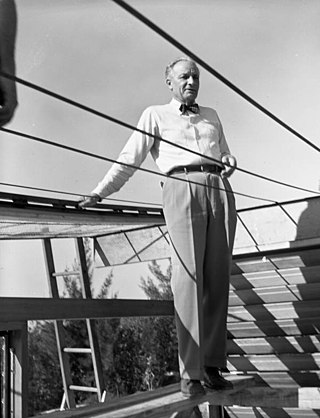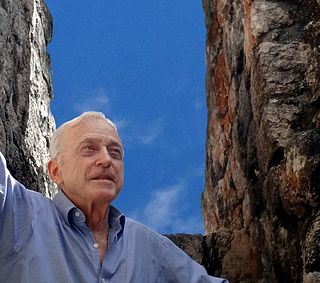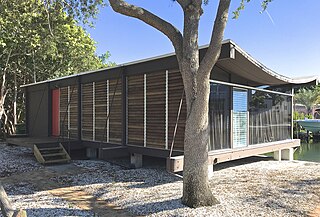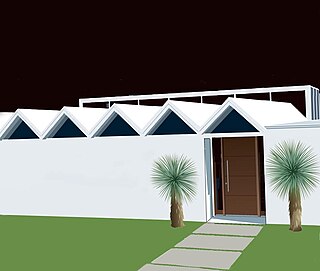The year 1918 in architecture involved some significant architectural events and new buildings.

Paul Marvin Rudolph was an American architect and the chair of Yale University's Department of Architecture for six years, known for his use of reinforced concrete and highly complex floor plans. His most famous work is the Yale Art and Architecture Building, a spatially-complex Brutalist concrete structure. He is one of the modernist architects considered an early practitioner of the Sarasota School of Architecture.
Gene Leedy was an American architect based in Winter Haven, Florida. He was a pioneer of the modern movement in Florida and later a founder of the Sarasota School of Architecture, whose members included Paul Rudolph, Victor Lundy, and others. After beginning his career in Sarasota, Leedy moved his practice to Winter Haven in 1954. He is best known for his bold use of exposed structural systems of precast concrete, especially in long-span, "double-tee" structural elements, as well as enclosed courtyards, flat roofs, and floor-to-ceiling sliding glass doors.

The Sanderling Beach Club is a historic Sarasota School of Architecture building in Sarasota, Florida, United States. It was designed in 1952 by architect Paul Rudolph.

The Sarasota School of Architecture, sometimes called Sarasota Modern, is a regional style of post-war modern architecture (1941–1966) that emerged on Florida's Central West Coast, in and around the city of Sarasota, Florida. It is characterized by open-plan structures, often with large planes of glass to facilitate natural illumination and ventilation, that address the unique indigenous requirements of the regional climate. Many of the architects who pioneered this style became world-renowned later in their careers, and several significant buildings remain in Sarasota today.

Mary Rockwell Hook was an American architect and a pioneer for women in architecture. She worked principally from Kansas City, Missouri but designed throughout the United States. She was denied admission to the American Institute of Architects (AIA) due to her gender.

The Revere Quality House is a house located in Siesta Key, Florida that was designed by architects Paul Rudolph and Ralph Twitchell. It is a breakthrough in twentieth-century residential architecture which blends elements of the International Style with site-sensitive design that is considered one of the notable examples of the Sarasota School of Architecture. The house represents a substantial advancement in how people should live within their environment, and established a new paradigm in tropical home construction.

The Florida Tropical House is a beach house located on Lake Michigan's shoreline in Beverly Shores, Indiana. It was built in 1933 as part of the Homes of Tomorrow Exhibition at the 1933 World's Fair in nearby Chicago. Today it is part of the Century of Progress Architectural District, a historic district.
Jack West was an architect in Sarasota, Florida and briefly in Southern California. West was one of the leaders of the Sarasota School of Architecture.

Ralph Spencer Twitchell was one of the founding members of the Sarasota School of Architecture. He is considered the father of the group of modernist architecture practitioners, that includes Paul Rudolph and Jack West, and other modernist architects who were active in the Sarasota area in the 1950s and 1960s like Ralph and William Zimmerman, Gene Leedy, Mark Hampton, Edward “Tim” Seibert, Victor Lundy, William Rupp, Bert Brosmith, Frank Folsom Smith, James Holiday, Joseph Farrell and Carl Abbott. He bridged the more traditional architecture of his early work in Florida during the 1920s with his modernist designs that began in the 1940s.

William J. Rupp was one of the modernist American architects considered part the Sarasota School of Architecture.

Carl Abbott is a Fellow of the American Institute of Architects and the youngest member of the original Sarasota School of Architecture.
Guy Wesley Peterson is an American architect based in Sarasota, Florida. He has designed more than 200 structures in southwest Florida, including private and public works. Peterson was an adjunct professor of architecture at the University of Florida, College of Design, Construction and Planning, and the author of Naked: The Architecture of Guy Peterson.
Edward John "Tim" Seibert was an architect based in Sarasota, Florida. Seibert was a Fellow of the American Institute of Architects and one of the founders of the modern movement known as the Sarasota School of Architecture.

The Healy Guest House is a small guest cottage located in Siesta Key, Florida, originally built for Mr. and Mrs. W. R. Healy. It was designed in 1948 by Paul Rudolph and Ralph Twitchell during their five-year partnership that sparked a modern architecture movement in Florida; the Sarasota School of Architecture. Its radical shape, featuring an inverted catenary roof, was an experiment in structure and technology. It is considered one of the most significant architectural works of the twentieth-century.

The Hiss Residence is a mid-century modern home designed by architect, Paul Rudolph. Built as the show home for Sarasota's Lido Shores neighborhood in 1953, the structure blends international style modernism with indigenous tropical design. It is among the preeminent works of the Sarasota School of Architecture and considered “one of the most remarkable homes of the twentieth century.”
Philip Hanson Hiss III (1910-1988) was an American real estate developer, who supervised the redesign of schools in Sarasota, Florida and helped found New College of Florida there.

The Walker Guest House was a compact modern beach structure originally built on Sanibel Island, Florida, for Dr. Walter Walker. It was designed in 1952 by Paul Rudolph as an architectural response to Mies van der Rohe’s Farnsworth House and Philip Johnson’s Glass House. It is considered a ground-breaking work of environmental design, and one of the most important works of architecture of the twentieth century.

The Zigzag House (1959) is a residential house in Sarasota, Florida, United States. It was designed by architect Tollyn Twitchell in the style of the Sarasota School of Architecture: the style is also referred to as a mid-century modern. The home has been named for its zigzag roofline which resembles saw teeth.

Milam Residence is an oceanfront residence in Ponte Vedra Beach, Florida, United States. It was designed by architect Paul Rudolph in the style of Sarasota Modern. The late modernist home has an unusual facade of large geometrical shapes facing the ocean. Completed in 1961, it was one of Architectural Record's 20 "Record Houses" of 1963. In 2016, it was added to the National Register of Historic Places.


























